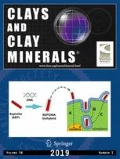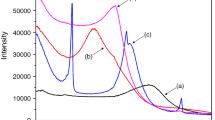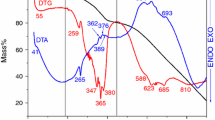Abstract
A series of organic ammonium ions were exchanged onto clay minerals montmorillonite and hectorite. Thermal effects on these surface modified organic-inorganic complexes were investigated by means of differential thermal analysis and heating-oscillating X-ray diffraction methods. It was found that the organo-clay complexes were dehydrogenated at temperatures from 180 to 350°C, depending on the organic cation used. Following the dehydrogenation, hydrolysis took place leaving a layer of “carbon” on the clay surface. The “carbon” was then oxidized at a temperature of about 550°C. Investigation of possible correlations between the activation energy of dehydrogenation and basicity, boiling point, ionization potential, molecular structure, and carbon-carbon bond distances of the organic cations showed that the geometric factors outweighed the acid, chemical and electronic factors in determining the effect of montmorillonite and hectorite toward the dehydrogenation of organic ions exchanged on the surfaces of these clay minerals.
Résumé
Une série d’ions d’ammonium organique ont été échangés sur des minéraux argileux montmorillonite et hectorite. Les effects thermiques sur ces complexes organiques-inorganiques à surface modifiée ont été &tudiés par l’analyse thermique différentielle et la méthode de diffraction des rayons X chauffage-oscillation. On a trouvé que les complexes organo-argile étaient déshydrogénés à des températures de 180 à 350°C, selon le cation organique utilisé. A la suite de la déshydrogénation, l’hydrolyse prenait place en laissant une couche de carbone sur la surface argileuse. Le carbone était alors oxydé à une température d’environ 550°C.
La recherche des corrélations possibles entre l’énergie d’activation de la déshydrogénation et la basicité, le point d’ébullition, le potentiel d’ionisation, la structure moléculaire et le lien carbonecarbone des cations organiques a montré que les facteurs géométriques dépassaient les facteurs électroniques, chimiqes et acides en déterminant l’effect de la montmorillonite et de l’hectorite vers la déshydrogénation des ions organiques échangés à la surface de ces minéraux argileux.
Kurzreferat
Eine Reihe organischer Ammoniumionen wurden auf den Tonmineralen Montmorillonit und Hektorit ausgetauscht. Die thermischen Effekte auf diesen oberflächenveränderten organischanorganischen Komplexen wurden mit Hilfe differential-thermischer Analyse und Heizung-Oszillierung Röntgenbeugungsmethoden untersucht. Es wurde festgestellt, dass die Organo-Tonkomplexe, je nach dem zur Verwendung gelangten organischen Kation, bei Temperaturen von 180 bis 350°C dehydriert wurden. Auf die Dehydrierung folgte eine Hydrolyse nach welcher eine “Kohlenstoff” Schicht auf der Tonoberfläche zurückblieb. Der “Kohlenstoff” wurde dann bei einer Temperatur von etwa 550°C oxydiert.
Eine Untersuchung möglicherweise bestehender Korrelationen zwischen der Aktivierungsenergie der Dehydrierung und Basizität, Kochpunkt, lonisationspotential, Molekularstruktur und Kohlenstoff-Kohlenstoff Bindungsabstände, der organischen Kationen zeigten, dass die geometrischen Faktoren die chemischen und elektronischen Faktoren an Bedeutung übertrafen bei der Feststellung des Effektes von Montmorillonit und Hektorit auf die Dehydrierung von organischen Ionen, die an der Oberfläche dieser Tonminerale ausgetauscht werden.
Резюме
Проведено насыщение глинистых минералов-монтмориллонита и гекторита-серией органо-аммониевых ионов. С помощью дифференциально-термического анализа и рентгеновского метода качания (съемка при повышенной температуре) проведено изучение термических эффектов на поверхностях глин, измененных под действием органо-неорганических комплексов.
Установлено, что органические комплексы глин теряют водород в диапазоне температуры 180 – 350°С в зависимости от используемого органического катиона. После выхода водорода наступает процесс гидролиза, который приводит к тому, что на поверхности глины остается только слой из атомов углерода (“углеродный слой”). Затем при температуре около 550°С происходит окисление этого поверхностного углерода.
Исследование возможной связи между энергией активации выхода углерода и основностью, температурой кипения, потенциалом ионизации, молекулярной структурой и межатомными расстояниями углерод—углерод в органических катионах показало, что геометрические факторы в большей степени, чем кислотные, химические и электронные факторы, определяют влияние монтмориллонита и гекторита на процессы выхода водорода из органических ионов, поглощенных поверхностными слоями этих минералов.
Similar content being viewed by others
References
Allaway, W. H. (1949). D.T.A. of clays treated with organic cation: Proc. Soil Sci. soc. Am. 13, 183–188.
Bear, J. L., and Wendlandt, W. W. (1961). The thermal decomposition of the tris-(ethylene diamine) and tris-(1,2-propylene-diamine) chromium (III) chloride and thicyanate complexes: J. Inorg. Nucl. Chem. 17, 286–294.
Bodenheimer, W., Heller, L., Kirson, B., and Yarin, S. H. (1965) Organometallic clay complexes —III. Copper–polyamine clay complexes: Intern Clay Conf., Stockholm, Vol 2, pp. 351–363. Pergamon Press, Oxford.
Bradley, W. F., and Grim, R. E. (1948) Colloid properties of layer lattices: J. Phys. Chem. 52, 1404–1413.
Carthey, A. R. (1955) D.T.A. of piperidine-saturated clay minerals: SoilSci. 80, 337–347.
Dowdy, R. H., and Mortland, M. M. (1967) Alcohol– water interactions on montmorillonite surfaces—1. Ethanol: Clays and Clay Minerals 15 259–271.
Greene-Kelly, R. (1956) The sorption of saturated organic compounds by montmorillonite: Trans. Faraday Soc. 52, 1281–1286.
Grim, R. E. (1953) Clay Mineralogy: McGraw-Hill, New York, Chap. 9, 220–230.
Hoffman, R. W., and Brindley, G. W. (1960) Adsorption of non-aliphatic molecules from aqueous solutions on montmorillonite: Geochim. Cosmochim. Acta. 20, 15–29.
Jordan, J. W. (1949) Alteration of the properties of bentonite by reaction with amines: Mineral Mag. 28, 598–605.
Kissinger, H. E. (1959) Reaction kinetics in differential thermal analysis: Anal. Chem. 29, 1702–1706.
MacEwan, E. M. C. (1948) Complexes of clays with organic compounds: Trans. Faraday Soc 44, 349–367.
Mackenzie, R. C. (1957) The Differential Thermal Investigation of Clay: Mineral Soc., London, 157.
McAtee, J. L., Jr. and Hawthorne, J. M. (1964) Heating-oscillating X-ray diffraction studies of some organomontmorillonites: Am. Mineralogist 49, 247–257.
Ramachandran, V. S. and Kacker, S. P. (1954) The thermal decomposition of dye-clay mineral complexes: J. Appl. Chem. 14, 455.
Ramachandran, V. S., Gray, S. P., and Kacker, S. P. (1961) Mechanism of thermal decomposition of organomontmorillonite: Chem. Ind., 790–792.
Reed, R. L., Weber, Leon, and Gottfried, A. S. (1965) Differential thermal analysis and reaction kinetics: Ind. Eng. Chem., Fundamentals 4, No. 1, 38.
Talibudeen, O. (1955) D.T.A. technique: J. Soil Sci. 3, 251–260.
Author information
Authors and Affiliations
Rights and permissions
About this article
Cite this article
Chou, C.C., McAtee, J.L. Thermal Decomposition of Organo-Ammonium Compounds Exchanged onto Montmorillonite and Hectorite. Clays Clay Miner. 17, 339–346 (1969). https://doi.org/10.1346/CCMN.1969.0170603
Received:
Published:
Issue Date:
DOI: https://doi.org/10.1346/CCMN.1969.0170603




